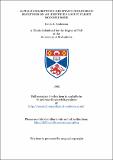Alpha-bungarotoxin-resistant cholinergic receptors on an identified locust flight motoneurone
Abstract
1. There is a population of alpha-bungarotoxin-resistant cholinergic receptors on the soma of the first basalar motoneurone of the locust, Schistocerca gregaria. 2. The receptors have a broadly muscarinic pharmacology: the response to pressure-applied ACh can be reversibly reduced by the global muscarinic antagonists atropine and dexetimide, and the vertebrate muscarinic subtype-selective antagonists pirenzepine (M1 subtype-selective), 4-DAMP (M3), p-F-HHSiD (M3>M1>M2) and methoctramine (M2). 3. In the presence of alpha-bungarotoxin, however, nicotine evokes a current similar to those induced by the muscarinic agonists muscarine, McN-A-343 and carbachol under voltage clamp; the nicotine-induced current can be blocked by the muscarinic antagonist scopolamine, suggesting that these 'muscarinic' receptors have a 'mixed' cholinergic pharmacology. 4. Under voltage clamp, activation of the receptors by the muscarinic agonists muscarine and McN-A-343, and the cholinergic agonist carbachol (in the presence of alpha-bungarotoxin) evokes an inward current at command potentials between -100 and 0 mV. This current is time- and voltage-dependent: the current component evoked at potentials more negative than -40 mV is relatively small, and either increases continuously during 15 min exposure to agonist, or increases to a maximum after 5 or 10 min before decreasing. At potentials more positive than -40 mV, the current component is larger, and increases continuously in the presence of drug. In approximately 50% of neurones voltage clamped at a holding potential of -50 mV, the inward current is preceded by an initial outward current at potentials positive to -40 mV. After 1 min exposure to agonist, the outward current reverses and becomes inwardly-directed, increasing in amplitude in the presence of agonist. 5. The apparent inward current evoked by McN-A-343 at potentials positive to -40 mV is due to the inhibition of a voltage-dependent K+ current, and may involve the production of cAMP. Activation of the 'mixed' receptors also stimulates the release of Ca2+ from intracellular stores. 6. The input resistance of the neurone, measured under current clamp, is increased by McN-A-343 in some preparations and decreased in others. The agonist decreases the spike threshold of the neurone, and therefore the physiological role of these 'mixed' receptors may be to modulate the excitability of the neurone.
Type
Thesis, PhD Doctor of Philosophy
Collections
Items in the St Andrews Research Repository are protected by copyright, with all rights reserved, unless otherwise indicated.

